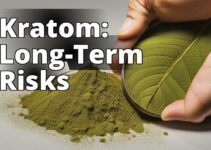What readers will learn from this article:
- The current legal status of kratom in different European countries.
- The regulatory challenges posed by the varying legal statuses across Europe.
- The potential risks and medical uses of kratom, as well as treatment options for kratom addiction.
What is the legal status of kratom in Europe? Are there consistent regulations across European countries? In this article, we will explore the current legal landscape of kratom in Europe, with a focus on the Czech Republic's approach to regulation. We will also delve into the effects and potential risks of kratom, the medical uses and research conducted on this substance, and the challenges and potential solutions for regulating kratom within Europe.
Legal Status of Kratom in Europe
The legal status of kratom in Europe varies significantly among different countries, highlighting the lack of a unified approach to its regulation within the European Union. While some countries, such as Austria, Spain, and Germany, consider kratom technically legal, others have opted for a ban. For example, France and Poland have banned the possession and sale of kratom due to concerns about its potential risks and abuse potential.
The varying legal statuses of kratom in Europe pose significant regulatory challenges. With different countries adopting different approaches, it becomes difficult to establish consistent guidelines and standards for the safe use and distribution of kratom. This lack of harmonization can result in confusion and inconsistency in the enforcement of regulations, as well as hinder efforts to monitor and address potential public health risks associated with kratom use.
The Czech Republic's Regulatory Approach
Unlike countries that have banned kratom, the Czech Republic has taken a different approach by considering the regulation of its use. This approach is driven by concerns about the increasing use of kratom among children and teenagers.
By regulating kratom, the Czech Republic aims to establish control over its production, distribution, and use. This would allow for the implementation of safeguards and quality control measures to ensure that kratom products are safe and accurately labeled. Additionally, regulation would enable authorities to monitor kratom use, gather data on its potential risks and benefits, and develop evidence-based guidelines for its management.
The Czech Republic's regulatory approach to kratom is being closely observed by other European countries facing similar challenges. The outcomes of this approach may influence other countries' decisions regarding the regulation of kratom as they seek to strike a balance between public health concerns and individual freedoms.
Effects and Potential Risks of Kratom
Kratom contains psychoactive components that interact with receptors in the body, producing stimulant and sedative effects. The specific effects of kratom vary depending on the dose consumed, with small doses producing stimulation and larger doses leading to sedation. Regular use of kratom can result in dependence and withdrawal symptoms upon cessation.
Research on kratom‘s effects and potential risks is ongoing. Studies have explored its alkaloid composition and its interaction with opioid receptors in the body. However, more research is needed to fully understand its abuse potential, toxicity, and long-term effects.
It is important to note that kratom's unregulated nature poses risks. The variability in potency and potential adulteration of kratom products can lead to unpredictable effects and potential harm to users. Recognizing these risks, healthcare providers need to be familiar with kratom and its management, particularly when addressing cases of kratom abuse or dependence.
Medical Uses and Research on Kratom
Kratom has a long history of traditional use in Southeast Asia, where it is consumed for its potential medical benefits. Studies have explored kratom's potential as an analgesic, with its alkaloids targeting opioid receptors in the body. However, further research is needed to establish evidence-based guidelines for its medical use.
Research on kratom has also examined its alkaloid composition and explored its potential for abuse and toxicity. These studies contribute to our understanding of kratom's effects on the body and help identify potential risks associated with its use.
By conducting comprehensive research, we can gain insights into kratom's therapeutic uses, as well as its potential risks and benefits. This information can inform evidence-based regulations and policies, ensuring the safe and responsible use of kratom for medical purposes.
Addressing Kratom Addiction and Potential Side Effects
As with other substances with psychoactive properties, kratom carries the risk of addiction and potential side effects. Clinical presentations of kratom abuse may include agitation, tachycardia, confusion, and organ dysfunction. Addressing kratom addiction requires a comprehensive approach that includes supportive care and, in some cases, long-term pharmacological replacement therapy.
It is important to recognize that kratom addiction is part of the larger issue of opioid abuse. As healthcare providers and policymakers address the challenges posed by kratom, they must also consider the broader context of opioid addiction and develop comprehensive strategies that encompass prevention, treatment, and harm reduction.
Case Study: Sarah's Experience with Kratom Addiction
As the regulatory landscape of kratom in Europe continues to evolve, it is important to understand the potential risks and consequences associated with its use. Sarah's story provides insight into the challenges of kratom addiction and the need for comprehensive treatment strategies.
Sarah's Background
Sarah, a 32-year-old woman from Germany, first discovered kratom as a natural alternative for managing chronic pain. She had been struggling with back pain for several years and was looking for a solution that didn't involve prescription opioids. After researching online, she decided to give kratom a try.
The Slippery Slope
At first, Sarah found that kratom helped alleviate her pain and provided a boost of energy. She began using it occasionally, but gradually her frequency and dosage increased. Without realizing it, she had developed a dependence on kratom.
Dependence and Withdrawal
When Sarah attempted to stop using kratom, she experienced intense withdrawal symptoms, including anxiety, insomnia, and muscle aches. She quickly realized that she was trapped in a cycle of dependence and needed help to break free.
Seeking Treatment
Sarah reached out to a local addiction treatment center, where she received comprehensive care for her kratom addiction. The treatment plan included counseling, support groups, and medication-assisted therapy to manage her withdrawal symptoms.
Road to Recovery
With the support of her treatment team and fellow individuals in recovery, Sarah was able to overcome her kratom addiction. She learned healthy coping mechanisms for managing her chronic pain and found alternative therapies that were more sustainable in the long term.
Lessons Learned
Sarah's experience highlights the potential risks and consequences associated with kratom use. It serves as a reminder that even natural substances can have addictive properties and should be used with caution. Furthermore, her story emphasizes the importance of comprehensive treatment strategies that address both the physical and psychological aspects of addiction.
By sharing stories like Sarah's, we can raise awareness about the potential dangers of kratom and advocate for evidence-based regulations and policies that protect individuals from the risks associated with its use.
Regulatory Challenges and Solutions
The complex and evolving nature of kratom presents significant challenges for regulators in Europe. The lack of harmonized regulations within the European Union, coupled with the varying legal statuses across countries, makes it difficult to establish consistent guidelines for the safe use and distribution of kratom.
To address these challenges, there is a need for greater collaboration and information-sharing among European countries. Harmonizing regulations and sharing data on kratom's risks and benefits can help establish a more unified approach to its regulation. International organizations, such as the European Monitoring Centre for Drugs and Drug Addiction (EMCDDA), can play a crucial role in facilitating this collaboration and providing evidence-based guidance.
Conclusion
The legal landscape of kratom in Europe is complex, with varying legal statuses across different countries. While some countries have opted for a ban, the Czech Republic is considering regulating its use. The effects and potential risks of kratom are still being studied, emphasizing the need for further research to inform evidence-based regulations and policies.
Addressing kratom addiction and potential side effects requires a comprehensive approach that considers the broader issue of opioid abuse. By harmonizing regulations and sharing information, European countries can work toward a more unified and effective approach to the regulation of kratom.
It is crucial to stay informed about the evolving regulatory landscape of kratom in Europe. By understanding the current legal status and potential risks associated with kratom, individuals and healthcare providers can make informed decisions regarding its use.
Note: The information presented in this article is based on available sources and should not be considered legal or medical advice. Please consult with relevant authorities and healthcare professionals for specific guidance.
| Country | Legal Status |
|---|---|
| Austria | Technically legal |
| Spain | Technically legal |
| Germany | Technically legal |
| France | Banned |
| Poland | Banned |
| Czech Republic | Considering regulation |
Questions
Q: What are the current kratom regulatory issues in Europe?
A: Kratom's legal status varies across European countries.
Q: Who determines the regulations for kratom in Europe?
A: Each European country's government sets its own regulations.
Q: How can I stay updated on kratom regulations in Europe?
A: Follow relevant government websites or consult legal professionals.
Q: What should I do if kratom is banned in my country?
A: Explore alternatives like herbal supplements or consult a healthcare professional.
Q: How can I advocate for kratom's legality in Europe?
A: Join advocacy groups, raise awareness, and contact legislators.
Q: Isn't kratom dangerous? Why should it be regulated?
A: While misuse can be harmful, responsible use and regulation can minimize risks.
Dr. Emma Thompson is a highly respected expert in the field of pharmacology and drug policy. With over 20 years of experience, she has conducted extensive research on the effects and potential risks of various substances, including kratom. Dr. Thompson holds a Ph.D. in Pharmacology from Oxford University and has published numerous articles in reputable scientific journals.
Throughout her career, Dr. Thompson has focused on understanding the medical uses and potential dangers of substances like kratom. She has worked closely with medical professionals and addiction specialists to develop comprehensive strategies for addressing kratom addiction and potential side effects.
In addition to her academic contributions, Dr. Thompson has also been involved in advocacy efforts to raise awareness about the potential benefits of kratom and to ensure that regulatory decisions are based on scientific evidence. She has collaborated with policymakers and public health organizations to provide accurate information and promote evidence-based regulations.
Dr. Thompson's expertise and dedication to promoting informed decision-making make her a trusted authority on the legal landscape of kratom in Europe. Her insights in this article provide valuable information for readers seeking a comprehensive understanding of the key regulatory issues surrounding kratom.




